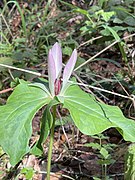
Trillium is a genus of about fifty flowering plant species in the family Melanthiaceae. Trillium species are native to temperate regions of North America and Asia, with the greatest diversity of species found in the southern Appalachian Mountains in the southeastern United States.
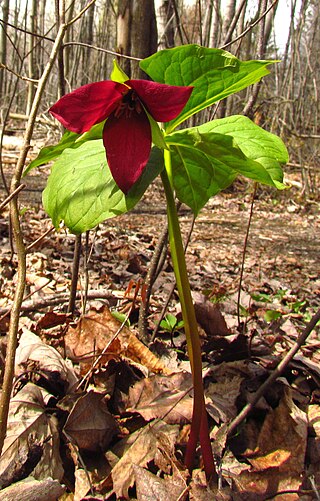
Trillium erectum, the red trillium, also known as wake robin, purple trillium, bethroot, or stinking benjamin, is a species of flowering plant in the family Melanthiaceae. The plant takes its common name "wake robin" by analogy with the European robin, which has a red breast heralding spring. Likewise Trillium erectum is a spring ephemeral whose life-cycle is synchronized with that of the forests in which it lives. It is native to the eastern United States and eastern Canada from northern Georgia to Quebec and New Brunswick.

Tiarella, the foamflowers, is a genus of flowering plants in the family Saxifragaceae. The generic name Tiarella means "little turban", which suggests the shape of the seed capsules. Worldwide there are seven species, one each in eastern Asia and western North America, plus five species in eastern North America. As of October 2022, the taxonomy of Tiarella in eastern North America is in flux.
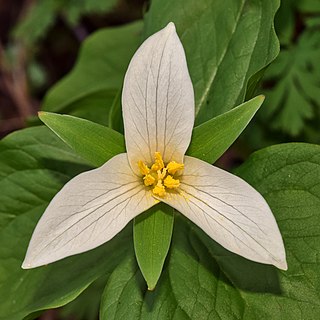
Trillium ovatum, the Pacific trillium, also known as the western wakerobin, western white trillium, or western trillium, is a species of flowering plant in the family Melanthiaceae. It is found in western North America, from southern British Columbia and the tip of southwestern Alberta to central California, east to Idaho and western Montana. There is an isolated population in northern Colorado and southern Wyoming.

Trillium luteum, the yellow trillium or yellow wakerobin, is a species of flowering plant in the bunchflower family Melanthiaceae with native populations in the Great Smoky Mountains of the United States and surrounding areas.

Trillium flexipes, known as the nodding wakerobin, bent trillium, or drooping trillium, is a species of flowering plant in the family Melanthiaceae. It is found from Minnesota to Ohio, south to Tennessee, with isolated populations in New York, Pennsylvania, Alabama, and other states. It is an endangered species in Ontario and possibly extirpated in North Carolina.

Trillium cuneatum, the little sweet betsy, also known as whip-poor-will flower, large toadshade, purple toadshade, and bloody butcher, is a species of flowering plant in the family Melanthiaceae. It is native to the southeastern United States but is especially common in a region that extends from southern Kentucky through central Tennessee to northern Alabama. In its native habitat, this perennial plant flowers from early March to late April. It is the largest of the eastern sessile-flowered trilliums.
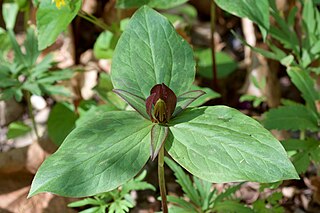
Trillium sessile is a species of flowering plant in the bunchflower family Melanthiaceae. The specific epithet sessile means "attached without a distinct stalk", an apparent reference to its stalkless flower. It is commonly known as toadshade or toad trillium. It is also called sessile trillium or sessile-flowered wake-robin,, however it is not the only member of the genus with a sessile flower.

Trillium cernuum is a species of flowering plant in the bunchflower family Melanthiaceae. The specific epithet cernuum means "drooping, curving forwards, facing downwards", a distinctive habit of its flower. It is commonly called nodding trillium or nodding wakerobin since the flower is invariably found nodding beneath the leaves. It is sometimes referred to as the northern nodding trillium to distinguish from Trillium rugelii, a similar nodding species native to the southern Appalachian Mountains. It is also called the whip-poor-will flower since presumably its bloom coincides with the spring arrival of the migrating bird with the same name.
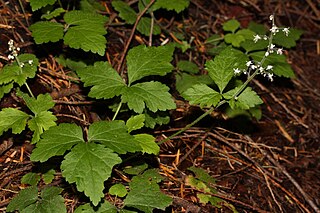
Tiarella trifoliata, the three-leaf foamflower, is a species of flowering plant in the family Saxifragaceae. The specific name trifoliata means "having three leaflets", a characteristic of two of the three recognized varieties. Also known as the laceflower or sugar-scoop, the species is found in shaded, moist woods in western North America.
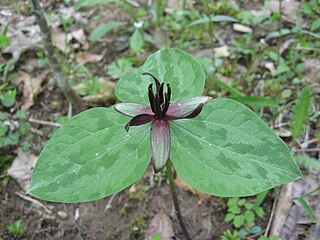
Trillium stamineum, the twisted trillium, also known as the Blue Ridge wakerobin, is a species of flowering plant in the family Melanthiaceae. It is native to the southeastern United States, in Alabama, Mississippi and Tennessee. Its natural habitat is calcareous woodlands.

Trillium sulcatum is a species of flowering plant in the bunchflower family Melanthiaceae. The specific name sulcatum means "furrowed, grooved, or sulcate", which describes the tips of the sepals. It is most abundant on the Cumberland Plateau in central Tennessee and eastern Kentucky where it blooms in April and May. The species is commonly known as the southern red trillium or furrowed wakerobin.

Trillium pusillum is a species of flowering plant in the family Melanthiaceae known by the common names dwarf trillium, least trillium and dwarf wakerobin. It is native to the southeastern and south-central United States from Oklahoma to Maryland.

Trillium albidum is a species of flowering plant in the bunchflower family Melanthiaceae. It is the only trillium characterized by a stalkless white flower. The species is endemic to the western United States, ranging from central California through Oregon to southwestern Washington. In the San Francisco Bay Area, it is often confused with a white-flowered form of Trillium chloropetalum. In northern Oregon and southwestern Washington, it has a smaller, less conspicuous flower.

Trillium petiolatum, the Idaho trillium, also known as the long-petioled trillium or round-leaved trillium, is a species of flowering plant in the family Melanthiaceae. It is native to the northwestern United States, in Idaho, Oregon, and Washington. The type specimen for this species was gathered by Meriwether Lewis in 1806 along the Clearwater River during the return trip of the Lewis and Clark Expedition.
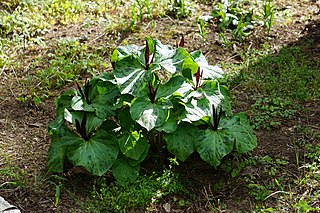
Trillium angustipetalum, with the common name is narrowpetal wakerobin, is a species of Trillium, plants which may be included within the Liliaceae or the newer family Melanthiaceae.
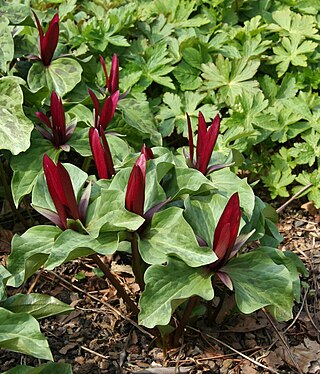
Trillium kurabayashii is a species of flowering plant in the bunchflower family Melanthiaceae. The species is endemic to the western United States, occurring in extreme southwestern Oregon, northwestern California, and the Sierra Nevada of northern California. It was first described by John Daniel Freeman in 1975. The specific epithet kurabayashii honors Masataka Kurabayashi, a Japanese cytologist and population geneticist who first postulated the taxon’s existence. It is commonly known as the giant purple wakerobin, a reference to its conspicuously large, dark purple-red flower, one of the largest of any sessile-flowered trillium.
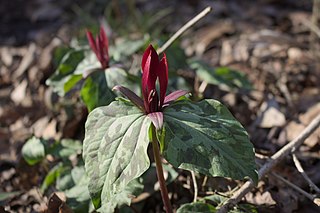
Trillium maculatum, the spotted wakerobin or spotted trillium, is a species of flowering plant in the family Melanthiaceae. It is found only in the eastern United States.
Trillium viride, commonly called the wood wakerobin, is a species of flowering plant in the family Melanthiaceae. It is found in the central United States, in certain parts of Missouri and Illinois. The specific epithet viride means "youthful" or "fresh-green", an apparent reference to the color of the plant's flower petals. For this reason, it is also called the green trillium, not to be confused with other green-flowered trilliums such as T. viridescens and the green form of T. sessile, both of which are found in Missouri.
Trillium hibbersonii is a species of flowering plant in the bunchflower family Melanthiaceae. The specific epithet hibbersonii honors the English Canadian surveyor John Arthur Hibberson (1881–1955) who first collected this plant in 1938 on Vancouver Island in British Columbia. Hibberson and his son propagated the trilliums, selling them to buyers in England and other European countries. In 1968, Leonard Wiley coined the Latin name Trillium hibbersonii, a name that has since been used by horticulturists without reservation.




